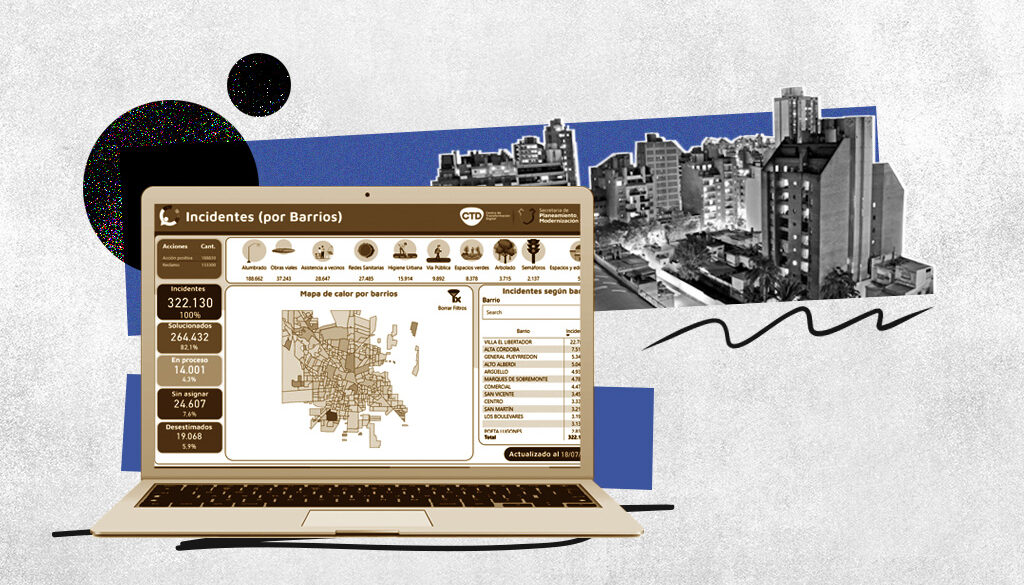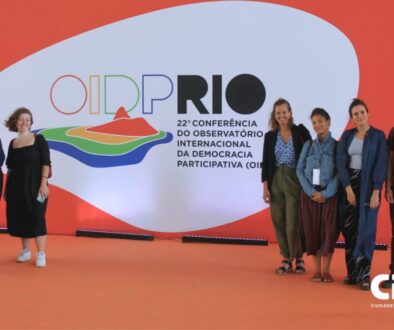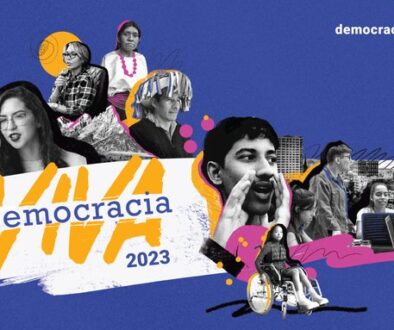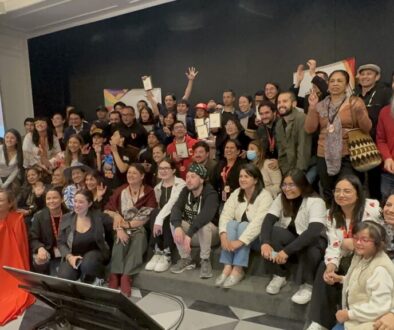Why Cordoba is considered a smart city and what challenges still need to be overcome for technology to help improve public management
Getting your Trinity Audio player ready... |
Two years ago, the municipality launched a digital management platform that functions as a communication channel between the government and citizens, thanks to which 81% of more than 300,000 neighborhood requests have been resolved. However, civil society organizations claim that the use of these technological resources does not yet promote a real participation of all people in decision making.
Smart cities are those that use connectivity, sensors distributed in the environment and other technologies to solve immediate problems, organize urban scenarios and generate innovative responses to improve people’s quality of life.
“The smart city model is recent but more and more municipalities are trying to adapt their resources to new technologies, especially ICT (information and communication technology),” says Spanish author Olga Santos Rubio in her book Ciudad inteligente, modelo de planificación y gestión, caso de la ciudad de León (Spain, 2015).
According to specialists in the field agree, each city has to design its own smart city model based on its characteristics and intrinsic factors.
In Argentina, an example of a smart city is Córdoba, according to the Asociación Civil Red de Innovación Local (RIL), which has been working since 2014 to improve the management capacities of local governments and ensure that people can have quality of life and opportunities to develop in their cities.
In December 2019, the city of Cordoba adhered to provincial Law No. 10,618 on Simplification and Modernization of the Administration, which involved implementing measures towards transparency, participation and public accountability and sanctioning rules on data openness in an active portal.
Thus, it created the Digital Transformation Center (CTD), which has digitalized almost 100 procedures and services. This space provides management tools based on the use of data and evidence, and has the Digital Transformation Observatory, a unique repository of intelligent dashboards with data, analytical evaluations and maps that it shares with neighbors. “Some outstanding dashboards are the App Ciudadana data and the savings calculator,” points out Romina Tricarico, RIL’s Inspiration Director.
In the App Ciudadana mobile app, Cordobeses register incidents in a georeferenced way from Google Maps related to lighting, sewage, urban hygiene and traffic lights. The platform allows the monitoring of the complaint in real time, without intermediation, and performs automatic communications of the progress of the management of the requirement. Since the launching of its pilot test in 2021, more than 300 thousand complaints have been submitted by neighbors, of which more than 81% have been resolved so far.
The application’s savings calculator, which provides information on the monetary and ecological savings obtained as a result of the digital transformation, reports that since December 2019 the city of Cordoba saved 3.5 billion pesos. This reduced the environmental impact through the use of almost 50 billion fewer liters of water and avoided the felling of almost 5 thousand trees, which would have been used to carry out paper formalities.
Useful resources
“The Municipality of Córdoba has made considerable progress in recent years in terms of digitalization of management, from the incorporation of information and communication technologies in the processes, which has made it possible that procedures that were previously performed in person can now be performed remotely (e.g.: online appointments, civil registry procedures, business authorization, private works, among others). This has made it possible for procedures that were previously carried out in person to be carried out remotely (e.g.: online appointments, civil registry procedures, business authorization, private works, among others)”, explained the Red Ciudadana Nuestra Córdoba, a plural, non-partisan and autonomous space in which more than 200 citizens from 60 organizations of the city participate and which is part of the Civil Society Board of the Federal Open Government Program. “The online procedures guide allows citizens to know how to operate in relation to the procedures they need to carry out before the municipality. The Citizen App to file complaints and follow up on them, and the Digital Neighbor (VeDi) platform, which centralizes all services and platforms related to the municipality, also constitute advances. This reduces waiting and processing times, contributes to simplifying processes, reducing bureaucracy and speeding up responses to citizen complaints”, they add. María, a resident of Barrio Centro who renewed her driver’s license, points out that the digital application was convenient, easy and intuitive and that she did not have to leave her house until the last step: “When I arrived to pick up the physical license at the Community Participation Center (CPC) of Barrio Jardín, I only had to announce myself so they could take my picture and that was it”.
Another example of the use of ICTs in public services is the Tu Bondi application, launched in August 2022. This tool provides real-time information on the location of the vehicles in circulation in the city and allows to know, for example, the estimated time of arrival at each stop. In less than a year, Tu Bondi reached 1,003,332 registered users and had 58 million visits, with an average of 5,800 to 7,000 users in real time.
On the other hand, Red Nuestra Córdoba also points out that, although there is a pending debt in including the neighbors in the government management, “in the pandemic, technologies allowed the realization of public hearings with citizen participation”.
The gap between digital government and open government
The expression “digital government” refers to the incorporation of ICTs to improve the administrative management of the State, both within public organizations and in relation to citizens.
However, digital government is not synonymous with open government, according to Paola Ninci, Emilse Carrizo, María Beatríz Valencia and María Silvia Corbalán, members of Red Nuestra Córdoba.
“Open government is a paradigm and a way of governing that aims to democratize public management, to make it more open, more transparent, more participatory. To this end, strategic information must be opened, which allows to control public management and also to open the relevant decision-making processes for citizen participation”, they explain. And they add: “Today in Córdoba there are important decisions related to urban interventions, urban planning agreements, changes in land use, etc. that involve structural decisions for which there is no information available and that affect environmental resources and have an impact on infrastructure, services and people’s quality of life. Citizens not only do not have information on government actions a posteriori, but also do not have access to prior information on the planning and decision-making process leading to these interventions. Monitoring and citizen participation, therefore, have practically no chance of becoming a reality”.
For Red Nuestra Córdoba, the applications and the digitalization strategy of the municipality are focused only on streamlining procedures. “Of 31 applications accessed through VeDi, none of them allows the submission of notes and the one for access to public information does not always have answers. Those that could provide information are inefficient: for example, the electronic bulletin and the municipal digest do not publish all the resolutions or ordinances, the bidding and auction site does not allow to know bidders and awardees, the Open Government Portal has many of its data outdated”, they detail.
The Red Nuestra Córdoba is critical of the absence of a participatory planning process in the neighborhood participation boards for the development of district plans: “The information available on the open government website is not relevant for the development of diagnoses, nor does it allow citizens to access, know and monitor the implementation of the plans defined by the boards,” say the network’s members.
The role of the citizen
Based on the Inter-American Development Bank (IDB) report The Road to Smart Cities: Migrating from Traditional Management to the Smart City (2016), “a smart city is one that places people at the center of development, incorporates information and communication technologies in urban management, and uses these elements as tools to stimulate efficient government information, including collaborative planning processes and citizen participation. By promoting integrated and sustainable development, smart cities become more innovative and competitive, attractive and resilient, thus improving the lives of their citizens and entrepreneurs”.
In this sense, from Red Nuestra Córdoba: “New technologies could collaborate to generate a system of articulation of actors that allows decision making from the territories with the participation of diverse voices, approaches and knowledge. For this, it is essential, on the one hand, that their designs allow interactivity, collective construction of information and its public availability. Likewise, technologies must be accompanied by offline policies and actions aimed at promoting and facilitating citizen involvement in public policies”.
As a result of the digitalization, the municipality received five innovation awards from IC Latin America and the International Foundation for Local Development.
In a management balance, “we can say in general terms that accessibility to municipal procedures and services has improved for citizens. Of course, we are talking about the part that can carry out online procedures, we would have to see what happens with those who cannot access the digital channels”, questions the Network team.
According to RIL, it has been proven that when institutions share information and access to relevant data, decision-making can be promoted at different levels, which helps to foster innovation and collaborative creation, thanks to the inclusion of different perspectives and the possibility of creating projects that add real value.
Sharing public challenges
“For more than eight years we have been building a network in Latin America that connects, accelerates, inspires and connects thousands of people working to solve the public challenges of cities. There are infinite possibilities for collaboration between cities that share thematic areas of action,” RIL explains. Other cases of smart cities highlighted by the organization are those of waste management in San Francisco, United States, and irrigation management in Medellín, Colombia.
Through a system of sensors, the city of San Francisco resolved its challenge of responding to 10,000 public complaints about dirt and unhealthy conditions in public spaces. This was achieved through a partnership between the Department of Public Works and the company Nordsense, which installed sensors in waste containers to monitor overflow and vandalism. The sensors allow real-time monitoring of waste levels and receive an alert when the container is full. In addition, they report whether the waste container is upright and secure. In addition, they help reduce carbon emissions and transportation costs because through their use, transportation collection workflows are optimized. As a result, San Francisco was able to improve the cleanliness of city streets.
For risk management, Medellín (Colombia) implements the Valle de Aburrá Early Warning System (SIATA), which monitors environmental conditions, identifies hazards and emergencies, and informs the decision-making process of response agencies in situations of extreme weather events. The system provides access to real-time information to determine the probability of events such as torrential rains, floods, landslides, avalanches, air quality analysis, electrical discharges, and areas where fires may occur. The actions carried out by SIATA are: monitoring, modeling, alerts and communication to the public.
This article is part of the Soluciones platform, a partnership between Río Negro and RED/ACCIÓN.
This article was previously published in Red/Acción on July 19, 2023.




